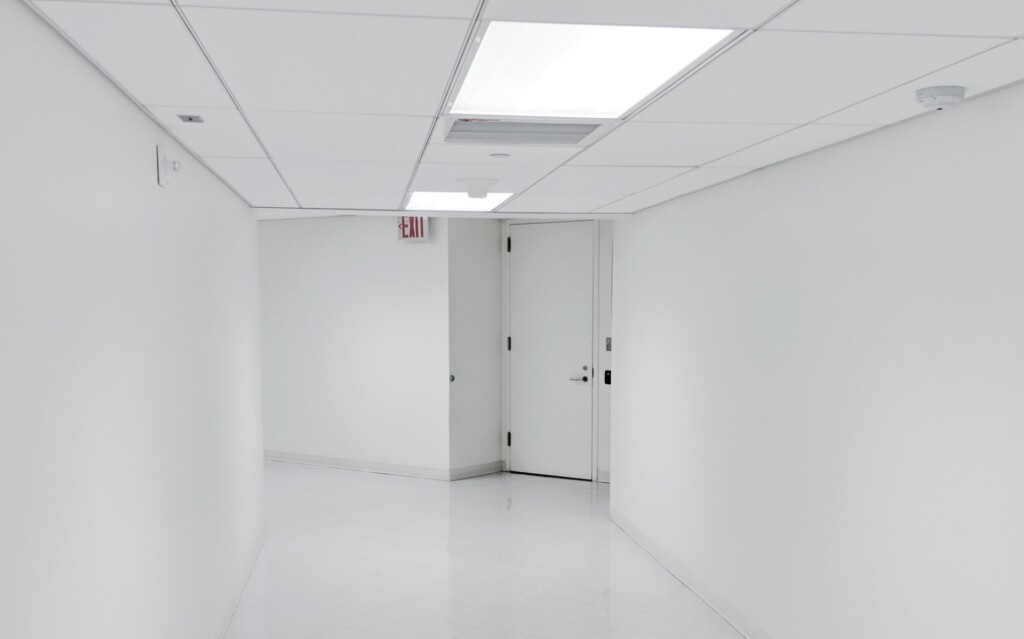Commercial corridors create critical pathways during emergencies, yet many building owners overlook how these spaces connect to safety systems. We encounter projects where corridor layouts seem functional for daily operations but fail to meet egress standards when analyzed through construction drawings.
Commercial corridor egress requirements in Irving establish the framework for safe movement from interior corridors through exits to the outside. This system addresses corridor exit access paths, designated exit doors, stairway connections, and exit discharge routes that terminate at a public way.
How Does A Corridor Fit Into The Means-Of-Egress Path?

The means of egress three-part system creates a continuous path from occupied spaces to safety. Corridors serve as exit access, the first component that guides occupants from their starting point toward an exit. This exit access path includes areas between desks, aisles in office buildings, and the corridors themselves that define and provide egress travel routes.
From corridors, occupants move to the second component: the exit. These exits include exterior exit doors at ground level, enclosed exit stairways with fire-resistance-rated construction, exit passageways, and exterior exit stairs. The exit provides protected egress travel between the exit access and what follows next.
The final component, exit discharge, carries occupants from the termination of the exit to a public way. This portion encompasses driveways, yards, courts, and parking lots that complete the safe egress route. Exit discharge ensures occupants reach genuine safety outside the building structure.
We coordinate these three components during construction planning to verify each connection functions properly. The exit access path must lead clearly to exits without confusion. Exits must provide adequate protection and capacity. The exit discharge route must offer unobstructed access to public streets or other approved safe areas.
Building diagrams demonstrate these sequential connections from corridor exit access paths through exits and into discharge routes. Each component serves a specific function in the overall egress system, and we verify that corridors integrate seamlessly with both exits and discharge routes during our construction process.
What Distance And Stairway Factors Should Corridors Account For?
Corridor design must account for specific travel distance limits that guide how we route occupants to safety. The 250-foot maximum travel distance to exit discharge creates a clear boundary for our egress planning. We measure this distance along the natural path of travel from the most remote point in a corridor through stairways to the final discharge point.
Interior exit stairways serve as the primary vertical circulation component in most commercial buildings. These enclosed stairways connect multiple floors and must terminate at exit discharge or extend through an exit passageway to the outside. We design these stairways with fire-rated enclosures that protect occupants during evacuation.
Exterior exit stairways provide an alternative egress route that discharges directly to grade level or a public way. These stairways eliminate the need for occupants to travel through interior building spaces during evacuation. The 250-foot travel distance limit applies from the corridor entry point to where occupants reach the exterior stairway.
Open stairways present specific challenges for corridor egress planning. Building codes restrict unenclosed stairways to two-story connections in most commercial occupancies. We can incorporate open stairways as exit access components when they connect no more than two stories and meet specific sprinkler system requirements.
Enclosed stairway systems offer greater flexibility for multi-story buildings. These fire-rated enclosures allow vertical travel between multiple floors while maintaining separation from corridor spaces. We coordinate stairway locations to ensure corridor occupants can reach at least one enclosed stairway within the maximum travel distance.
Travel distance calculations include the path through corridors plus any distance traveled within stairways themselves. We measure stairway distances along a plane parallel to the stair treads at the center of the stairway width. This comprehensive measurement ensures total egress time stays within acceptable limits for occupant safety.
Which Egress Door Features Matter Along Commercial Corridors?

Egress doors function as critical transition points where corridors connect to safe exit routes. These designated exit doors must incorporate specific components that facilitate rapid, unobstructed movement during emergency situations. We focus on ensuring these doors support the continuous flow from exit access through to exit discharge.
Essential Hardware Components For Safe Operation
Exit doors require hardware that allows immediate opening without keys, tools, or special knowledge. Push bars and panic hardware enable quick operation under stress conditions. The door must swing in the direction of egress travel, allowing people to exit efficiently even when pressed against the door by crowd pressure.
Door width specifications ensure adequate capacity for occupant loads. The minimum 32-inch clear width accommodates wheelchair users and allows multiple people to exit simultaneously. We verify that door openings maintain this clear width when doors are fully open, accounting for stops, hardware, and any protruding elements.
Threshold And Opening Force Requirements
Door thresholds cannot exceed one-half inch in height to prevent tripping hazards during emergency evacuation. This specification becomes particularly important where people may be moving quickly or assisting others who have mobility limitations. Beveled edges on thresholds further reduce the risk of falls.
Opening force limitations ensure doors remain operable by individuals with varying physical capabilities. Interior doors typically require no more than 5 pounds of force to open, though fire doors may require additional force as specified by applicable codes. We coordinate these requirements during door selection and installation.
Vision Panels And Identification Features
Vision panels in egress doors allow people to see conditions beyond the door before opening. These panels help prevent collisions and allow assessment of safe passage routes. The bottom edge of vision panels must be positioned no higher than 43 inches above the floor to accommodate users of various heights, including those using wheelchairs.
Required signage includes illuminated EXIT signs positioned above or adjacent to egress doors. Tactile EXIT signs must be placed adjacent to doors leading to exit stairways and exit discharge routes. These signs help people locate exits in low-visibility conditions and provide tactile confirmation for individuals with visual impairments.
Fire Rating And Smoke Protection Elements
Fire-rated doors include specialized components that maintain their protective function during fire events. Self-closing mechanisms ensure doors remain closed to prevent fire and smoke spread through corridor systems. Intumescent strips expand when exposed to heat, sealing gaps around the door frame to block smoke infiltration.
Door frames must maintain the same fire rating as the door assembly to preserve the protective barrier. We coordinate frame installation with wall construction to ensure continuous fire-rated assemblies. Proper installation of door hardware maintains the integrity of these fire-protective systems throughout the building’s operational life.
How Should Evacuation Plans Reflect Corridor Egress In Irving?
We develop evacuation plans that translate corridor egress requirements into clear visual guidance for building occupants. Effective evacuation plans combine floor plan diagrams with emergency procedures, creating actionable documents that occupants can follow during fire, flooding, or other emergency situations.
The floor plan becomes the foundation of corridor egress mapping. We include all exit access paths from corridors to designated exits, marking each route with arrows that show the direction of travel. Exit doors receive clear identification, whether they lead to enclosed stairways, exterior stairs, or directly to the outside. The diagram also shows exit discharge routes from each exit to the public way.
Visual Mapping Elements
Route diagrams require specific visual elements to support corridor egress flow. We mark corridor paths with distinct arrows that guide occupants from their location to the nearest exit. Each exit receives a symbol and label that identifies whether it connects to interior stairways, exterior stairways, or direct discharge routes.
Emergency assembly areas appear on evacuation plans with clear marking and distance indicators. We show the path from exit discharge to these assembly points, ensuring occupants understand where to gather after leaving the building. This mapping helps prevent confusion at exit discharge points and reduces crowding near building exits.
Emergency Procedures Integration
Emergency steps complement the visual floor plan with specific actions for different scenarios. Fire emergency procedures outline which corridor routes to use and which exits to avoid if smoke or fire blocks primary paths. Each set of emergency steps includes instructions for checking doors, staying low in corridors filled with smoke, and proceeding to designated assembly areas.
We structure emergency procedures in numbered steps with short, direct language. These steps address different emergency types, from fire evacuation that emphasizes quick exit via corridors, to severe weather procedures that may direct occupants to interior areas rather than exits. Clear procedures help occupants make quick decisions about corridor routes during actual emergencies.
According to OSHA evacuation planning guidelines, floor diagrams should include locations of exits, assembly points, and emergency equipment such as fire extinguishers and first aid kits. Plans should also account for employees with special needs who may require extra assistance when evacuating through corridors to exits.
Conclusion And Next Steps

Commercial corridor egress requirements in Irving establish a clear path from occupied spaces through corridors to safe exit discharge. The means of egress system connects corridor exit access to properly designed exits, including interior and exterior exit stairways and egress doors, before reaching a public way. Travel distance limits of 250 feet govern corridor design, while stairway types must account for enclosure requirements and fire-resistance ratings.
We verify these egress systems through comprehensive building diagrams and evacuation plans that map corridor paths, identify exit components, and confirm discharge routes. Construction teams should review project diagrams against code requirements for stairway types, travel distances, and exit discharge paths to ensure all egress elements function as an integrated system. Ready to ensure your commercial project meets Irving’s corridor egress requirements? Contact EB3 Construction to discuss your project’s means of egress planning.




